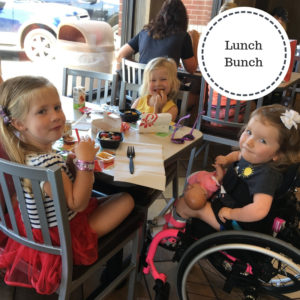Continued from “Reflections on Raising a Child in a Wheelchair :: Part 1 — Inclusion, Advocacy, & Accessibility.”
Most of the moms I meet genuinely want their children to understand disability and differences, but aren’t quite sure how to teach them.
 I don’t fault anyone for being confused or awkward when confronted with something outside her normal experience. I wasn’t close to anyone with a disability before I became a mom to a child with Spinal Muscular Atrophy (SMA). When my daughter first showed signs of hypotonia at eight weeks old, I remember being terrified of the idea she might not play sports one day. A wheelchair back then was unthinkable!
I don’t fault anyone for being confused or awkward when confronted with something outside her normal experience. I wasn’t close to anyone with a disability before I became a mom to a child with Spinal Muscular Atrophy (SMA). When my daughter first showed signs of hypotonia at eight weeks old, I remember being terrified of the idea she might not play sports one day. A wheelchair back then was unthinkable!
But now, I can assure you, those wheels are as much a part of our life and my daughter’s identity as your child’s brown eyes or curly hair. And that wheelchair — the one I was once so afraid of — is now the greatest gift of independence and freedom for a little girl who just wants to move and explore like any other child her age.
So I’m sharing with you a few things you can teach your children when it comes to wheelchairs and differences, in hopes that as you gain new perspective, you can guide your little ones to a better understanding too.
Say Hello
If you teach your child one thing about children in wheelchairs, please teach them to say “hello!” If you run into us at the store or at church, I promise you’ll have no choice because my daughter will probably say it first. But the few times we’ve dealt with stares, I always try to break the ice with a friendly greeting.
“Emme, I think that little girl wants to say hello to you!”
It immediately stops any awkwardness and opens the door for understanding and friendship.
It’s Okay to Ask
Children are naturally curious. When they see something different, they may point and ask questions. One day, we were at the library, and a little boy pointed at Emme and said “Why is she in that chair?”
I answered, “It helps her move. Just like your legs help you walk, her chair helps her walk too.”
The answer satisfied his curiosity, but his mother quickly apologized to us in front of both children. I understand why she did this, but it’s important that we don’t make our children feel ashamed for wanting to understand differences. It was a learning opportunity, and a chance to build a bridge. A better response would have been to help him relate: “Don’t you like her pink wheels?” or “I bet she loves reading books just like you do!”
Don’t Push
 This is something I’m always telling other children. I know it’s so tempting. I mean, a wheelchair looks like a giant toy on wheels, right? But my daughter’s wheels are her legs. Just like you wouldn’t push another child to get something you want or to move them out of the way, you shouldn’t push a child in a wheelchair just because she rolls.
This is something I’m always telling other children. I know it’s so tempting. I mean, a wheelchair looks like a giant toy on wheels, right? But my daughter’s wheels are her legs. Just like you wouldn’t push another child to get something you want or to move them out of the way, you shouldn’t push a child in a wheelchair just because she rolls.
I always tell our friends and their children who want to push Emmeline in her chair to just ask. Most of the time, her answer is yes. She likes to play with her friends, and sometimes this is the best way for them to interact.
But remember, just as your child has control over her body, my child needs to have control over her chair. So this includes not hanging things from her handle, putting her chair in the locked position or decorating her chair without permission. If you think of her wheelchair as a part of her body, it will help you gain better perspective on what is or isn’t appropriate.
I’d love to open this up to answer other questions you may have! What have you encountered with your little ones? What questions do you have about teaching your children about disabilities?














What wonderful perspective Jenny! I especially liked the reminder to not push. That her wheelchair is her personal space! You are such a great mom!